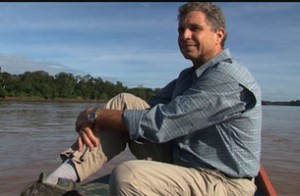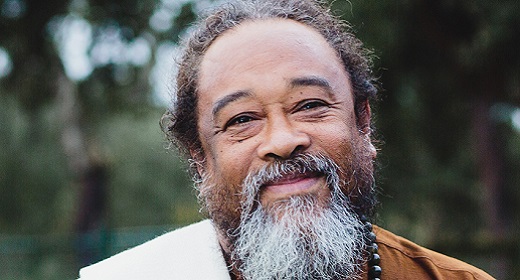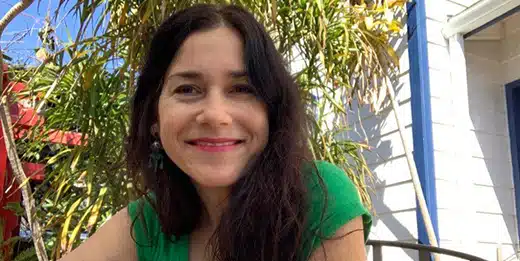by Alberto Villoldo Ph.D.: It was late in the spring of 1979, and I was an eager young man with a fresh PhD looking for an unexplored niche in anthropology; I had already spent nearly six years traveling to the Peruvian Andes and Amazon.  During these years, I came across the opportunity to study with many shamans and healers. Many of them were masters who worked with the ayahuasca vine, a plant with hallucinogenic qualities that is used ritualistically in their culture, which fascinated me. I remember observing one of these shamans, don Ramon, during his nighttime healing ceremonies, as he would load his pipe with jungle tobacco and turn to one of his patients and “sing his jaguar down from the tree.” I asked him what he meant and he explained that like many people, the patient lived in constant fear, and that this fear was the result of a trauma experienced early in life that had not healed. He said, “This man’s soul is like a terrified cat who escaped danger and quickly clambered up a tree, where it remains, hissing at anyone who comes near. The cat must come down, relax, and resume walking on the terra firma of the rainforest, or there will be no healing of the illness this fear has engendered in him.”
During these years, I came across the opportunity to study with many shamans and healers. Many of them were masters who worked with the ayahuasca vine, a plant with hallucinogenic qualities that is used ritualistically in their culture, which fascinated me. I remember observing one of these shamans, don Ramon, during his nighttime healing ceremonies, as he would load his pipe with jungle tobacco and turn to one of his patients and “sing his jaguar down from the tree.” I asked him what he meant and he explained that like many people, the patient lived in constant fear, and that this fear was the result of a trauma experienced early in life that had not healed. He said, “This man’s soul is like a terrified cat who escaped danger and quickly clambered up a tree, where it remains, hissing at anyone who comes near. The cat must come down, relax, and resume walking on the terra firma of the rainforest, or there will be no healing of the illness this fear has engendered in him.”
As he worked with his patients, don Ramon would speak to them softly, reassuring them that their family was safe, that they were safe. Sometimes, he would massage a patient’s belly, explaining to that “here is where the jaguar resides within each of us.” I told him that in the west, we call the primitive, fearful response to trauma the “fight-or-flight” response, because it causes a creature to run away from danger or lash out in self-protection. The old shaman nodded, and said, “Yes, but when the danger has gone, an animal no longer holds on to its fear, while people will often remain in this state for many years.”
The more I thought about it, the more excited I became about the potential of don Ramon’s jaguar medicine. His explanation made total sense. Resetting a fight-or-flight response could free a patient from the devastating physiological effects of stress. While the fight-or-flight response can save our life in an emergency, we know that it is damaging to remain in that state for an extended period. During fight-or-flight the body produces and releases cortisol, adrenaline, and norepinephrine, hormones that shut down noncritical functions in favor of high energy bursts, enhanced alertness, quickened reflexes, and faster blood clotting, all of which are needed in times of danger.
The danger is that our physiological response to chronic stress is the same as during instances of danger. Our fight-or-flight hormones continue to wash through our system, and we soon have an oversupply of cortisol and adrenaline. Excess levels of cortisol break down tissues in virtually every corner of the body, accelerating the aging process. High cortisol levels weaken ligaments, muscle, blood vessels, and bone and can cause elevated blood sugar levels and high blood pressure, eventually leading to easy bruising and thin, nearly transparent skin that we associate with the elderly. Abnormal function of the fight-or-flight system has also been correlated with inflammatory diseases and deficient immune function. While in this state, the body suppresses the healing hormones we need to recover from stress. And while most animals have systems that allow them to shake off the fight-or-flight response as soon as danger has passed, we humans seem to have lost that ability.
I watched don Ramon and other shamans “bring the jaguar down from the tree,” during their healing rituals and saw the immediate difference in their patients, who were visibly more relaxed and energized. Later, the healers would employ certain core processes including what they called “extraction” and “soul retrieval.”
The extraction process draws out the “heavy” or noxious energies that have settled in the patient’s body or his “luminous energy field” (LEF): the energetic envelope, or information field, that surrounds the physical body. This is the detoxification stage of healing, and it sometimes also involves ingesting plants that induce vomiting or herbs that cleanse the GI tract. The shamans explained to me that these illness-causing, energies were often the result of envy or anger that had been directed at the patient by someone else. When lodged in the LEF or in the outer layers of the skin, these energies had to be sucked out of the patient. The shaman would place his mouth over the affected area of the body, suck audibly, then turn and spit out the invisible poisons. Sometimes, the shaman would even vomit fiercely as his physical body rejected the noxious energies he had removed from his patient. Other times, the shaman would using a stone or crystal to extract and contain them.
Many of the shamans I studied during my tenure in the Amazon, and later in the Andes, explained to me that the (LEF) contains a blueprint for how we will age, how we will heal, and how we might die. Encoded within this matrix are all the gifts and ailments we inherit from our parents, as well as data from all the traumas we have suffered in our lifetimes. Stories of betrayal, abandonment, and loss are stored in a holographic fashion in the tides and streams of life-force swirling about in the luminous field, creating dark, heavy spots among the whirls of lighter energy. If we have a family history for heart disease or breast cancer, this information is encoded in our LEF until we are healed of this legacy. In the Amazon, they refer to such legacies as “generational curses” handed down from parent to child to grandchild. The shamans explained to me that when a sorcerer wants to inflict harm on a victim, he merely needs to activate the codes in the LEF to manifest a generational disease in that person. Conversely, a healer could also trigger the gifts latent within a clients LEF. In effect, these shamans believe that the LEF provides instructions to our DNA to express certain genes.
For many years, I considered their stories about creating health or disease in others to be implausible, but then I wondered, if diet, exercise, meditation, and stress can inform gene expression, couldn’t intention do the same? What about the well documented power of prayer to heal? Could someone with a malevolent intention send that toxic desire to exploit another’s weaknesses, in the same way that a benevolent prayer could heal?
After the resetting the fight-or-flight system and the detoxifying the patient, the shaman practices what is called “soul-retrieval.” This process summons the parts of the self that the patient has lost as a result of previous traumas. Don Ramon believed that these events, which the shaman called susto or “fright,” may have split off parts of the patient’s soul when she was an infant, or even in utero. Jealous spouses or competitors could also have stolen these soul parts—the confident self, the trusting self, the self who loves freely and feels worthy of being loved in return—in the patient’s adulthood.
To retrieve these talents, possibilities, and potentials that have retreated to the hidden recesses of the patient’s psyche, the healer will enter a trance state and allow his consciousness to temporarily depart from his body and journey to the “lower world,” or what we might identify as the collective unconscious. There, the healer can discover and bring back those qualities of the personality that have been disowned, and that will allow a patient to embark upon their destiny. At this stage of the healing, the shaman will also prescribe certain herbs and foods that will help the body to rebuild and restore physical health.
Shamans say that the soul has such a longing for wholeness that it will recreate the conditions that caused the soul loss, because it hopes that another opportunity for healing will result in our integrating these fragmented aspects of the self. Unaware of their soul’s wounding, the person will change jobs but end up with a similar boss, move to another city and wonder at how she ended up with neighbors who are just like those she left behind, or divorce the abusive spouse and end up in an identical marriage. If the shaman can discover the source of the original wounding, he can heal it, and break the self-destructive patterns. He does this by recovering the quanta of life force that was lost and returning it to its rightful place in the patients LEF.
Shamanic medicine is not a panacea, and shamans themselves will go to the emergency room when they have an acute condition. Western medicine remains the best trauma medicine that we know. Yet shamanic healing, with its emphasis on treating the body, mind, and soul as inseparable and continually influencing each other, can offer us fresh perspectives on dealing with the chronic conditions that afflict so many.
About the author:
Alberto Villoldo, PhD is a medical anthropologist who has spent the last 30 years investigating the healing practices of the shamans of the Amazon and the Andes. He is the founder of the Four Winds Society, an organization dedicated to the bridging of ancient shamanic traditions with modern medicine and psychology; and is the author of over 10 books, including Shaman, Healer, Sage; Mending the Past and Healing the Future with Soul Retrieval; The Four Insights and Yoga, Power and Spirit. His next book, Courageous Dreaming will be available in bookstores March 2008 and has already been chosen as a One Spirit selection of the month. The Four Winds Society, Healing the Light Body School provides a scientific framework through which it is possible to learn the ancient healing practices that can be “known but not told.” For more information visit www.thefourwinds.com







































